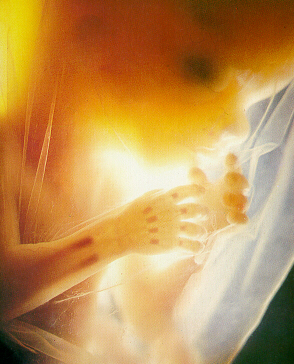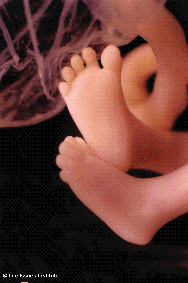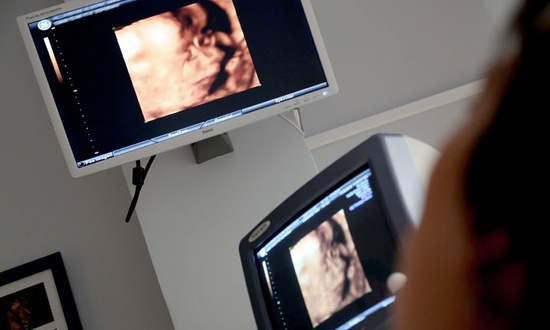 This contains descriptions of abortions. Most of the people quoted here are clinic workers or abortionists. Some are writers or medical students who have observed the procedures. All people quoted are pro-choice.
This contains descriptions of abortions. Most of the people quoted here are clinic workers or abortionists. Some are writers or medical students who have observed the procedures. All people quoted are pro-choice.
One medical textbook describes abortion this way:
"The uterus can usually be evacuated up to sixteen weeks of gestation with a large suction curettage or with the use of extraction forceps. After sixteen weeks, a combination of suction curettage followed by extraction of fetal parts and placenta with extraction forceps ensures evacuation of the uterine cavity."
Abortionist Dr. Warren Hern, in his textbook on how to do abortions, describes the procedures a little more plainly.
Here he describes a first trimester abortion. During the procedure:
"The physician will usually first notice a quantity of amniotic fluid, followed by placenta and fetal parts, which may be more or less identifiable."
Later he says:
"The procedure changes significantly at 21 weeks because fetal tissues become much more cohesive and difficult to dismember….A long curved Mayo scissors may be necessary to decapitate and dismember the fetus."
He also instructs:
"The aggregate fetal tissue is weighted, then the following fetal parts are measured, foot length, knee to heel length, and biparietal diameter"
This quote is from a medical student who observed abortions in a Planned Parenthood clinic.
"Really it's just inserting a vacuum device into the woman's cervix and sucking out all the contents of the uterus. First the cervix is numbed up with some lidocaine and another drug that constricts blood vessels so that there's less bleeding. Then her cervix is dilated (how much depends on how far along she is) with these metal rod-dy things. Then a plastic tube attached to the vacuum device is placed in her uterus, the vacuum is turned on, and then the tube is moved back and forth while rotating it to suck it all out. Then an ultrasound is done through the vagina to make sure the gestational sac is gone. Then we looked at what was sucked out after they wash out the blood and strain it. The first patient I saw was at 11 weeks and some days. I completely wasn't expecting it, but there were fetal parts. Like hands. And legs. And kidneys. It was pretty shocking. But, of course, after the initial shock, I was fine. I was actually fascinated by it. Until I saw one with a face. Complete with eyeballs…It's amazing to think that all of this can form within only a couple of weeks…"
From a New York Times author:
"After an abortion, the doctor must inspect these remains to make sure that all the fetal parts and placenta have been removed. Any tissue left inside the uterus can start an infection. Dr. Bours squeezed the contents of the sock into a shallow dish and poked around with his finger. "You can see a teeny tiny hand," he said." - Abortion Provider Dr. Bours
Author Sue Hertz spent a year observing in a busy abortion clinic. Here are a few excerpts from her book:
"It was easy to shrug off an aborted pregnancy as nothing more than a sack of blood and globs of tissue—as many pro-choice activists did—if one never saw fetal remains, or products of conception (POC) as they were known in medical circles. But the nurses, medical assistants, and doctors who worked inside procedure rooms...knew that an eleven-week-old POC harbored tiny arms and legs and feet with toes. At twelve weeks, those tiny hands had tiny nails. Although the fetal head was too small at this stage to withstand the evacuation machine's suction, pieces of face—a nose and mouth, or a black eye…were sometimes found in the aftermath...Later abortions spawned even more gruesome fetal remains…the head did not come out whole during the evacuation, but the legs and arms and rib cage made it through intact. The hand of a second trimester fetus, as a Preterm doctor described it, seemed big enough to shake."
She also describes an abortion:
"During the procedure, Doris would offer her hand for the patient to squeeze, or if the abortion were particularly painful, a notepad for the patient to bite...Doris knew what [the abortionist] was doing at the end of the examination table as he pored over the legs and ribs and hands, but she chose not to look. It wasn't that Doris ignored the truth, but rather that her commitment was to the woman, not the fetus..."
"...[the doctor] removed from the glass jar cheesecloth sack which caught the fetal parts, dumping the parts into a basin at the end of the table, between [the patient's] feet. Two legs, two arms, two fists, a skull, a backbone, a placenta. "We've got it" he announced."
"...As a provider at Repro once said, if half the pro-choice people saw the fetal remains of a 2nd trimester abortion, they would jump the fence into the antis' arms."
"But when I look in the basin, among the curdlike blood clots, I see and elfin thorax, attentuated, its pencilline ribs all in parallel rows with tiny knobs of spine rounding upwards. A translucent arm and hand swim beside." - Sallie Tisdale, Clinic Worker
"I am walking out the back door, and I see a plastic jar of tissue and blood waiting to be sent to the path lab, and in the plastic jar a tiny perfect white hand…" - Ann Finger, Clinic Worker
"You are doing a destructive process. Arms, legs, chests come out in the forceps. It's not a sight for everybody." - Dr. William Benbow Thompson of the University of California at Irvine
"It is advisable to use the biggest forceps that you can get through the cervix to morcellate the fetus….[the need to] "visually check the parts as they are retrieved" "is necessary to ensure complete evacuation but is part of the reason that second trimester abortion is not popular among surgeons. All those here who do second trimester abortions will agree that the most difficult ones are those between 14 and 16 weeks. In those, there is a tendency for the uterus to form an 'hourglass' and the head and part of the trunk to be trapped in the upper part and difficult to retrieve. The passage of large, recognizable fetal parts by the woman some hours or days later is extremely distressing for the woman and her family." - Dr. Cope, Abortionist
From the brief of Dr. Cahart Et. Al. In Steinberg V. Carhart:
"After a portion of the fetus has been removed, other parts of the fetus remaining in the uterus will sometimes be alive. J.A. 258 (Stubblefield) The district court found out that sometimes the embryo or fetus is brought into the vagina while it is still living and intact. S.A. 9, 28. Physicians know that suctioning a pre-viable fetus or embryo out of the woman's uterus will inevitably kill it."
 "I was watching the doctor struggle with the cannula, trying to pull it out," she said. "I didn't understand what the resistance was all about. And I was very alarmed and all of the sudden the doctor pulled the cannula out and there, as I was at the woman's side, I looked down at the cannula and there was a foot sticking out. I will never forget the feeling I had in my chest as the doctor pulled that cannula out. And it almost took the breath out of me. Because the reality of this was very hard for me...This sounds terribly cavalier, I suppose, but within about a month, like everything else we do after a while, it just becomes pretty routine and it has never bothered me since then." - Nurse from a Seattle Abortion Clinic
"I was watching the doctor struggle with the cannula, trying to pull it out," she said. "I didn't understand what the resistance was all about. And I was very alarmed and all of the sudden the doctor pulled the cannula out and there, as I was at the woman's side, I looked down at the cannula and there was a foot sticking out. I will never forget the feeling I had in my chest as the doctor pulled that cannula out. And it almost took the breath out of me. Because the reality of this was very hard for me...This sounds terribly cavalier, I suppose, but within about a month, like everything else we do after a while, it just becomes pretty routine and it has never bothered me since then." - Nurse from a Seattle Abortion Clinic
"You have to dismember the fetus. You have to actually pull pieces of the fetus out." - Former Abortionist Brian Finkel (Finkel was later convicted of sexually assaulting several of his abortion patients)
"In testimony Wednesday in St. Louis Circuit Court, [abortionist] Crist said that it is not uncommon for second-trimester fetuses to leave the womb feet-first, intact and with their hearts still beating. He sometimes crushes their skulls to get the fetuses out. Other times, he dismembers them."
"I didn't know if I could handle looking at the tissue; that was the big thing." She was training. "It's just—I mean it looks like a baby. It looks like a baby. And especially if you get one that comes out that's not piecemeal. And, you know, I saw this one that comes out, that's not piecemeal. And, you know, I saw this one, and it had its fingers in its mouth; …it makes me really sad that this has to happen, you know, but it doesn't change my mind, it's just hard." - "Janice," Clinic Worker, on dealing with the remains of abortions
Abortion clinic worker "Celia" discusses late term abortion. Her clinic injects Digoxin into the hearts of the babies before dismembering them:
"It's going to be weird now because you're going to see the sono. You're going to see the heart beating—little hearts, you know—and then, all of a sudden, you're going to put this cardiac medicine in it to make it stop—to kill it. I won't kill it, the doctor will kill it….It's just a harder reality check of what we're doing….It's like rationally I know this is going to be much better because, God, you know, if it can make a twenty-three-week skull come out easier, you know bless this digoxin."
Clinic worker "Karen" describes a 21 week abortion:
"You're looking between the woman's legs; you're seeing, you know, what the doctors doing….it's identifiable, I mean, when he….takes the forceps and pulls out a foot, you can see the foot…"
"I hate it when people put it together to look like a baby. I hate that…" - "Risa," Clinic Worker on handling dismembered remains from abortions
"Because it looks like a baby. That's what it looks like to me. You've never seen anything else that looks like that. The only other thing you've ever seen is a baby...You can see a face and hands and ears and eyes and, you know…feet and toes…It bothered me really bad the first time…" - "Nell," Clinic Worker, on seeing aborted babies
"And, in the beginning, yes, I remember standing behind this woman's shoulder [as she performed an early second trimester abortion] and thinking, I can't do this…Features are discernible, you can count five fingers on a hand, and five toes on a foot. You know, all the organ systems are formed. You know, you can see ears as structures, and the nose and eyes as structures….I think the destruction is hard." - "Sarina," Clinic Worker
One author who observed in an abortion clinic for one year describes an abortion:
"Still holding the forceps, Lane begins pulling, tearing apart the fetus. His first three tugs yield indistinguishable tissue. The fourth brings out more solid mass, which Anneke, from her position in the back of the small room, immediately recognizes as the trunk of a fetus.... Tiny hands and feet, extracted next, are the most recognizable. The head is less so. The pieces of the fetus and the placenta are placed by Lane on a surgical tray at his side."
Author Magda Denes witnessed abortions for her book In Necessity and Sorrow: Life and Death Inside an Abortion Hospital:
"I look inside the bucket in front of me. There is a small naked person in there floating in bloody liquid—plainly the tragic victim of a drowning accident. But then perhaps this was no accident, because the body is purple with bruises and the face has the agonized tautness of one forced to die too soon....I have seen this before. The face of a Russian soldier, lying on a frozen snow covered hill, stiff with death and cold....A death factory is the same anywhere, and the agony of early death is the same anywhere. I take the lid off all the buckets. All of them. I reach up to the shelf above this bucket and graveyard tabletop and take down a pair of forceps....With the forceps I lift the fetuses, one by one. I lift them by an arm or a leg...Finally, I lift a very large fetus...I look at the label. Mother's name: Catherine Atkins; Doctor's name: Saul Marcus. Sex of item: Male. Time of Gestation: Twenty-four weeks. I remember Catherine. She is seventeen, a very pretty blond girl...This is Master Atkins—to be burned tomorrow—who died like a hero....Might he have been the only one to truly love her?"
Denes interviewed Andre Winston, who delivered the aborted babies to the incinerator to be burned:
"In the ones where you could see the babies with the hands and the feet and the heads and everything, and you can tell what sex, a boy or girl. Really sometimes it gets nasty. They are so big sometimes. Some are small and still have hands. It's just too bad the baby had to go that far and end up here...Seeing what I've seen and everything—and I've worked around here and seen these dead fetuses. I wouldn't want to have to come here, or have my girlfriend come here, and have an abortion, and I end up seeing the kid that was almost mine, look where it ended up at."
An author from Salon Magazine describes two abortions. In the first case, the doctor decided to do a D & E abortion, where the baby is torn apart in utero:
"Once that decision was made, the resident inserted a long-handled metal instrument into the woman's uterus—called a Bierer forcep—and began what the doctor called "blind" pulling. I watched as the doctor instructed the resident to "Stop and feel where you are! Put your hand on the abdomen. No, you're not getting it! Watch out! Don't get the cervix."
Time after time, the resident plunged the Bierer into the woman's womb, removing a leg, then an arm, then the liver, then the placenta, which the doctor ranted about, because this can make the fetal head extraction more difficult. The last step that I saw was the collapse of the skull and the removal of the brain matter."
The second abortion was a Dilitation and Extraction abortion, also known as a Partial Birth Abortion, in which the baby is partially delivered and removed intact. He describes what he saw:
"The doctor, using only his fingers, pulled a foot into view and then another. "OK," he said, "now I have the sacrum." Letting the resident take over, the doctor instructed: "Pull down. Down! Not Up! Down! All right, now the shoulder, then twist. Then the other shoulder."… At this point, only a few minutes had passed. The fetus was perfectly limp, its tiny feet and hands flaccid as they immediately darkened from oxygen depletion...Once the entire fetal body was out of the womb, the doctor quickly made an incision into the base of the skull that remained lodged against the woman's cervix and inserted a suction catheter into the perforation to drain the brain matter and allow the full removal of the fetus. The placenta came next and the doctors finished suctioning the uterus to drain any remaining blood."
Here is another account of a partial birth abortion:
"The patient lay on her back on the operating table, her ankles dangled in the air, gently held by a loop of cloth tied to high steel poles. At the tap of a button, the bed rose, bringing her womb up to working level, and the doctor lowered a clear plastic face mask, like an arc welder's. The doctor inserted his gloved right hand deeply into the patient's vagina until only his thumb protruded.
''I am looking for a foot,'' he said to the resident standing beside him. I stood directly behind them. He pulled out a foot, a bit longer than an inch.
''There is the foot,'' he said. ''Now you pull the one leg and then you reach in and flex the other one like this.'' He re-inserted a single forefinger into the vagina and suddenly two legs, froglike, appeared. The skin was translucent, membranous. The feet quickly turned a dark purple. Within minutes, so did the legs. The doctor gripped each leg as if holding hedge clippers.
''Place each thumb on the buttocks,'' he instructed. The pads of his thumbs and the fetus's buttocks were perfect matches in size and shape.
''Then turn and twist like this.'' He pulled firmly. A back appeared, then with the flick of a forefinger, a small arm fell out and then another. The anesthesia had relaxed the natural paisley curl of the fetus into something linear and flaccid. A 10-inch homunculus, its head locked into the cervix, hung in full view, motionlessly toward the floor, its long tapered legs disturbingly elegant.
It happened quickly. The back of the fetus's skull was punctured. There was a tiny spurt of blood into the stainless-steel waste can that sat on the floor beneath. A curette was inserted, a hose was attached and the deep rumble of the suction machinery near me kicked on. Into a clear plastic jar at my feet there appeared instantaneously about a half-inch of pinkish fluid marked by tiny whitish-gray globules. On some animal level, deep in my own brain stem, I knew what it was and leapt back in fear. The periphery of my vision went gray, and a minute later, when my equilibrium returned, I found myself standing amid an ancient medical ritual."
The procedure is profoundly upsetting. The image of that limp suspended fetus has not left me. By the time I traveled back home—two days later—I had trouble holding my 8-month-old daughter..."
Dr. Maureen Paul, abortionist, says the abortions she performs:
"What I prefer to do is to just reach in with my forceps and collapse the skull and bring the fetus out intact." (Paul teaches abortion practice and was the lead author of a recent medical textbook on abortion.)
 "I dismember the fetus—pull it apart limb from limb—and remove it piece by piece and two hours later I've forgotten them." - Prof. Phillip Bennett, Abortion provider
"I dismember the fetus—pull it apart limb from limb—and remove it piece by piece and two hours later I've forgotten them." - Prof. Phillip Bennett, Abortion provider
The affidavit of "Employee B," a certified surgical technician employed at Midtown Hospital for a month and a half before resigning, describes Midtown's patient care:
On April 18, 1998, at approximately 7:00 a.m., I witnessed a patient deliver an intact fetus in the toilet of a bathroom in the waiting room area. After expelling the baby and the afterbirth, the patient walked to the operating room because there were no wheelchairs. I opened the fetal sac so that the fetus could be weighed. The weight was approximately 3029 grams [over 6 pounds, 10 ounces]. It was a very big fetus. My impression is that at Midtown Hospital a procedure will be done at any gestational age as long as the patient has the money.
Brief of Dr. Carhart et Al. in Stenberg vs Carhart:
After approximately 16 weeks gestation, the fetal head cannot typically be safely drawn through the woman's cervix unless it is compressed. J.A. 296 (Stubblefield) …the physician either compresses the skull with forceps before pulling it into the vagina or removes the cranial contents."
From St. Petersburg Times:
"Okay, Robin," [abortionist] Crist says after administering anesthesia. "You're going to feel some cramping sensations as I'm dilating your cervix."
The paper states, "He does this using a series of metal rods so he can get to the uterus, where the fetus is. The fetus is about6 inches long and weighs about four ounces. It has arms and legs and fingers and toes."
Later in the article:
"Here's an arm," he says, beginning an inventory that he does after every procedure to make sure all of the fetus has been removed.
"This is the head. Here is part of the spine…It's all there. On to the next patient."
"[D & Es] the procedure typically used for later abortions, have always been somewhat problematic because of the toughness and development of the fetal tissues….I kept doing D&Es because that was what I was comfortable with, up until 24 weeks. But they were very tough... I noticed that some of the later D&Es were very, very easy. So I asked myself why can't they all happen this way. You see the easy ones would have a foot length presentation, you'd reach up and grab the foot ofthe fetus, pull the fetus down and the head would hang up and then you would collapse the head and take it out. It was easy. At first, I would reach around trying to identify a lower extremity [i.e., a foot] blindly with the tip of my instrument. I'd get it right about 30-50 percent of the time. Then I said, 'Well gee, if I just put the ultrasound up there I could see it all and I wouldn't have to feel around for it.' I did that and sure enough, I found it 99 percent of the time. Kind of serendipity." - Dr. Martin Haskell, Abortionist
"Of the various ways to perform an abortion after the midpoint of pregnancy, there is only one that never, ever results in live births. It is D&E (dilatation and evacuation), and not only is it foolproof, but many researchers consider it safer, cheaper and less unpleasant for the patient. However, it is particularly stressful to medical personnel. That is because D&E requires literally cutting the fetus from the womb and, then, reassembling the parts, or at least keeping them all in view, to assure that the abortion is complete…" - From The American Journal of Obstetrics and Gynecology
Newspapers reported that Abortionist Robert Crist "cited instances when 9- or 10-week-old fetuses are unintentionally suctioned intact into the suction bottle. Sometimes, they're still alive, with their hearts visibly beating." - Dr. Crist is Planned Parenthood's Chief Abortion Physician in Missouri.
An abortion doctor describes his job:
"... As you get into the second trimester, if we remove the pregnancy using forceps, and if a heartbeat is the measure of being alive, that happens all the time."
 "I want to deal with the head last, because that's the biggest problem. From my point of view, the fetus is a potential problem to the patient." - Dr. James T. MacMahon, Abortionist
"I want to deal with the head last, because that's the biggest problem. From my point of view, the fetus is a potential problem to the patient." - Dr. James T. MacMahon, Abortionist
"The later ones though, they're bad—you see little arms and feet…little, but you know what they are, and you know what's really being done." - Unnamed Abortionist
"In a standard D&E, the fetus generally doesn't come out intact, but you might very well bring down a leg at the start of the procedure, and if the definition is a beating heart, potentially any second-trimester abortion could fit this bill..." - Allan Rosenfield, Professor of Obstetrics, University School of Public Health
Although the procedure [partial birth abortion] is viewed as distasteful, alternative procedures are equally distasteful. Whether a 16-week fetus is delivered by dilatation and extraction (by which the fetus is dismembered within the uterus) or whether the fetus is delivered intact by decompressing the cranium, or whether the mother's womb is injected with a substance that kills the fetus in utero, the outcome is the same for the fetus. The resulting complications to the mother from each procedure should be the question." - Benjamin Graber, Abortionist, Pompano Beach, Florida
"Sometimes during the D&E (dilation and evacuation) procedure, a part of the fetus protrudes from, or is pulled through the cervical os before the fetus is fully removed. Although in the vast majority of cases, there is fetal demise before this occurs, from the disruption occasioned by the suction and/or forceps, there could be rare instances where the fetus is 'living' within the meaning of the Act—whatever that meaning is—when part of the fetus is within the uterus and part is outside. ..." - Dr. Curtis Stover, Abortionist, Little Rock, Arkansas (comments from a court deposition)
"It's very difficult for me to determine whether the fetus is still living when it comes through the vagina." - Dr. Edward Martin, Medical Director, Abortion Clinic in South Miami called A Choice for Women
"I evacuate the fetus, I insert the forceps, and grasp the fetus, and pull, and sometimes the fetus comes out in pieces, and I make instrument passes until the entire fetus is evacuated, and sometimes the whole fetus will come down into the vagina, at least as far as the head." - Maureen Paul, Abortionist
"You certainly know that you will start with a living fetus and that it will be dead by the end of the procedure. But when you start a second-trimester abortion, you don't know when the fetus will die. Every patient is different." - Dr. Larry Carhart, late term Abortionist
"I'm sure I've had a situation, with a 14- or 16-week pregnancy, when the fetus presented feet first, where I did something that a Federal prosecutor might take to court under this language." - Dr. Louis Koplick, Abortion Doctor, New Mexico, commenting on how he believes D&E abortions may be effected by a Partial Birth Abortion Ban
B. D. Colen, a reporter for Newsday:
"I had spent a week in a clinic, watching first trimester abortions and interviewing the physicians doing them, the women having them, and the counselors working with those women...
None of that prepared me for what I saw that sunny afternoon in a sterile, white procedure room at The Washington Hospital Center...
After dilating, or opening, the cervix, the physician used a curette, the gynecological version of a sharpened spoon, to cut the fetus into pieces he would then remove with forceps. A large petri dish sat on an instrument stand to the right of the girl's feet, and most of the red material in the dish was unrecognizable. But from time to time during the procedure the physician would tap his forceps on the edge of the dish—and into the muck would drop a foot, or a hand, or a piece of rib cage...
Having seen what I saw, I cannot for a moment abide the disingenuousness of those who argue that a fetus is not human, or those who convince themselves that abortion is not killing...
Yes, abortion is killing. But it is not murder. Murder is legally banned killing. Abortion is one of many forms of legally and socially sanctioned killing."
"We were not supposed to perform abortions past 12 weeks. But it would—and did—happen that some women were aborted at 16 to 20 weeks. When that would happen, I would find that the tray contained blood, tissue and bone. That happened quite a lot and anyone who says it doesn't is lying." She was asked what she did with the tissue, bone, and blood, she replied, "I'd dump it in the sink, Just like it was a disposal. Tissue bones and blood. The first time I saw it, I said, 'Oh my God!' And then I washed it away down the sink. I'm ashamed I actually did that. I still think about it today. It's why I quit. Tissue, bone and blood," she repeated. "That's not life?" - Clinic Nurse
"On August 12 and August 22, a Charlotte Observer reporter saw a considerable amount of fetal tissue removed from the dumpster adjacent to the clinic. The remains, deposited in 10 to 15 large plastic trash bags, included readily identifiable body parts. Among them were a left forearm and hand, a left leg and foot, a right forearm and hand, part of a right foot, and a spinal column and rib cage. In several cases the remains had been dumped in trash bags along with ordinary garbage: coffee grounds, cigarette butts and remnants of chicken dinners."
The previous information was compiled by Sarah Terzo. You may view her website, which is complete with documented footnotes. You can find more quotes and detailed footnotes for this article here: http://clinicquotes.com/site/story.php?id=25



